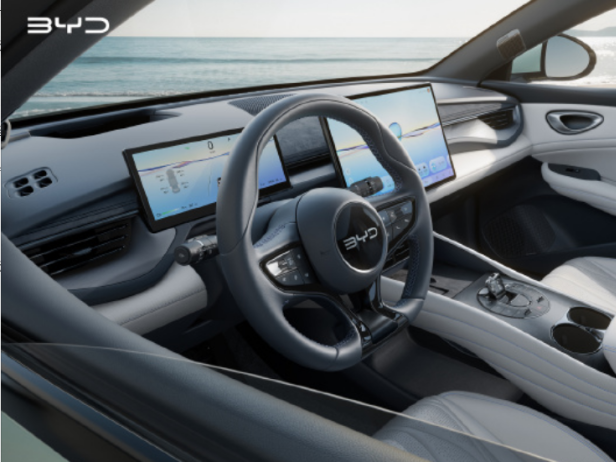Debunking the Cylinder Explosion Myth: It's All About Seizing
 JamesFeb 23, 2024, 09:25 PM
JamesFeb 23, 2024, 09:25 PM
An incident involving a cylinder explosion occurs when the car's tachometer enters the red zone, typically caused by elevated temperatures. This leads to the expansion of the piston, resulting in it becoming lodged within the cylinder. Consequently, the engine becomes irreparably damaged. In more severe instances, the excessive pressure prevents the piston from moving, causing the vehicle's four wheels to lock. This may be followed by the emission of a thick flame.
In gasoline engines, after the intake stroke enters the combustion chamber, the piston compresses it during the compression stroke. After the spark plug ignites the high-pressure mixed gas, the pressure generated by its combustion is converted into the engine's power. Although the combustion of the engine can be simply described in a few words, the study of the combustion of the internal combustion engine has harvested many Ph.D. and Master's theses. Many scholars and engineers have spent their lives studying the combustion. So to truly understand the engine, a lot of effort is required.
Because the combustion of the engine is very complicated, it requires accurate design and control. A slight control error or abnormality can cause abnormal combustion, and "knocking" is a kind of abnormal combustion. Simply put, knocking is the abnormal pressure in the combustion chamber caused by abnormal combustion.
The first is the poor heat dissipation effect of the engine, which causes the working temperature of the engine to exceed the temperature that the original design can withstand. Secondly, the quality or poor circulation of the engine oil causes insufficient lubrication. In addition, the adjustment of the engine's air intake and exhaust system and the ignition timing is not accurate. Finally, the engine's high workload will cause the so-called cylinder explosion or cylinder shrinkage. For racing cars with such high technology content, the possibility of the first few situations is relatively low, and the main problem should probably be the excessive load on the engine caused by their workload.
For race car engines, to have high-performance power output, their engine speed is always pulled to 15,000 rpm, and then under the use of gear changes and engine brakes when entering and exiting the corner, it can be said that they are always in a low-speed and high-speed state. Under different states, the relative engine speed is working between these constant highs and lows, which is a great test for the engine's durability. Apart from this, the internal parts of the engine are made of different metal materials due to different usage requirements, and they are precisely processed and completed. Due to different metals, their thermal expansion and contraction are also different.
Therefore, there is the so-called warm-up lap before the race, in addition to allowing the tires to reach the working temperature to increase the grip, and also to allow the various parts of the engine to reach the normal working temperature. After the engine reaches the initially set standard operating temperature, this engine can have the most perfect power output performance during the race. However, this is often one of the goals that engine engineers are constantly pursuing and breaking through.
Then the phenomenon of cylinder explosion is a problem occurring in the cooling and lubrication systems mentioned above, as well as the thermal expansion and contraction of metal materials and excessive use, and it is also possible that several factors occur at the same time. Nowadays, a Formula One car has six cylinders working at the same time, and it may be possible that only one cylinder is prone to cylinder explosion or cylinder shrinkage. The main reason is the severe wear or rupture of the piston ring and the cylinder wall of the piston in the cylinder.
The original tight cylinder is caused by the lubrication oil at the bottom of the engine compartment entering the combustion chamber. After it is burned, the exhaust gas that cannot be completely burned is discharged from the car through the exhaust system. That's the situation where a large amount of white smoke is seen at the rear of the car on TV. According to the size of the smoke, the severity of the cylinder explosion can be roughly judged, if this situation is more serious, it is very likely to cause oil leakage on the track surface, directly causing a high danger to other race cars.
The team's electronic monitoring system can monitor the various working states of the engine throughout the course. If the engine speed is constantly exceeding the limit, or when the temperature rises or there is insufficient oil pressure, the team will use radio communication to inform the driver to reduce the engine speed or slow down the car speed. Hoping to reduce the accident of cylinder explosion by not excessively pressing the engine power output. This is one of the reasons why we sometimes see a driver who can catch up with the leading driver for a while, but the speed will slow down after a few laps and cannot chase.
What the team technicians are most worried about is that all the monitoring of the racing engine during the race is normal, but the problems occur in an unpredictable state at the moment. After all, the inside of the engine is composed of a bunch of parts, and no one can guarantee that each part is perfect. In addition, the assembly of the racing engine is completed by the technicians themselves, so the technicians are one of the reasons. Then there are the driver's driving skills and the actual state of the race, which are variable factors that the computer system cannot control in advance.
Suppression Method of Cylinder Explosion
The quickest and most effective method to suppress knocking is to retard the ignition advance angle to reduce combustion pressure. So the principle of the knock sensor action is that when the engine knock is detected, the ignition advance angle is delayed to a timing that will not knock. After the engine no longer knocks, the ignition advance is slowly restored. The knock sensor uses an accelerometer to measure changes in the engine's acceleration, that is, vibration. When engineers tune the knock sensor, they write the vibration mode of knocking into the ECU. Once the knock sensor detects this vibration mode, the ECU will determine the engine knocks, and then delay the ignition advance angle. More advanced knock sensors can even determine which cylinder is knocking, and individually delay the ignition advance angle for that cylinder.
When it comes to cylinder explosion, what everyone cares most about is the question of what gasoline to add. 93, 97, or 98 are the anti-knock properties of gasoline, that is, their "octane number". What is an "octane number"? During the study of the relationship between fuel and knocking, researchers found that "iso-octane" is most resistant to knocking, while "n-heptane" is quite easy to knock, so the anti-detonation degree of iso-octane is set to 100, and n-heptane is set to 0. The gasoline with an octane number of 97 is that its anti-knock degree is the same as the anti-knock degree of a mixture of 97% iso-octane and 3% n-heptane.
So this is purely a problem of anti-knock performance, and it is not that the higher the octane number of gasoline, the stronger the engine. Of course, if you add gasoline with too low an octane number and cause knocking, or when knocking occurs, the engine retires from the ignition corner, the car will indeed be weaker. In other words, as long as the engine does not knock, increasing the octane number of the fuel will not make the engine stronger or more fuel-efficient, it will only make your wallet shrink.
Distinction of Cylinder explosion
"Seize cylinder" and "Cylinder explosion" have been misread for many years.
In the true sense, the cylinder explosion should be written as "seize the cylinder", which is simply the piston in the car's engine holding together with the cylinder. The cause of the failure is the piston due to the lack of engine oil for cooling, the piston temperature rises and expands to hold the cylinder in place (the piston and the cylinder stick together). This situation will not produce smoke, if there is a racing car suddenly stopped on the race track, and there is no smoke, it may be a gearbox problem, for example, the Indian force driver Fisichella’s retirement in the previous game was caused by the gearbox.
After the seized cylinder condition, the engine is scrapped, even if it can be repaired, the engine condition after the repair is very difficult to restore to the original level. The main reasons for the cylinder seizure are the super load of the car, the intense overspeed, lack of lubricating oil, failure of the cooling system, etc. If you want to verify the principle of seizing the cylinder yourself, it is very simple. Empty all the engine oil from the engine, and then drive for tens of kilometers and the engine will seize.
Fishtank Explosion One
The fishtank is cracked, due to the poor quality of the fishtank, leading to cracking.
Fishtank Explosion Two
Nevertheless, the explosion here is different from the above. The explosion here is that the aquatic organisms in the fish tank grow and breed too fast due to the suitable environment, and the fish tank is full.
If any infringement occurs, please contact us for deletion

BYD Seal 06 GT is about to debut: a cruising range of 600km and a new pure electric GT choice
On August 23, BYD Ocean Network officially announced that its brand new pure electric mid-size sedan is named BYD Seal 06 GT, which will debut at the Chengdu Auto Show in China on August 30. The new car is built on the BYD e 3.0 Evo platform, adopts a new ocean aesthetic design language, and is aimed at the mainstream pure electric mid-size sedan market.The official statement, BYD Seal 06 GT will become the first GT created by the BYD Ocean Network, promoting the development of the seal series i

605 km range: 2025 BYD Song Plus EV debuts with upgraded smart cabin
On August 19th, it was learned from BYD official that the 2025 BYD SONG PLUS EV officially went on sale. The new vehicle has launched three configuration models with a price range of 149,800 - 175,800 RMB. As a revised model, the new car has been upgraded in detail, intelligence, and three major aspects of configuration, adding 19-inch two-color wheel hubs, new Xuantian color / sandy rice interior color matching, equipped with intelligent cockpit high-end version -DiLink100 and standard 16 core

BYD Yangwang U9 officially delivered: 0-100 km/h in 2.36 seconds, top speed of 300 km/h
On August 16th, we learned from the official of Yangwang Auto that the first car of its second model, Yangwang U9, officially came off the assembly line and is about to start delivery. The new car was launched on February 25th at a price of 1.68 million yuan. Yangwang U9 is positioned as a pure electric sports car with easy four-way platform technology and Yun-N-X intelligent body control system, accelerates from 0-100km/h in 2.36 seconds, and can reach a top speed of 300km/h.On the exterior, th

Official interior pictures of BYD SEAL 06GT release, the first GT for young people has arrived
On August 26, BYD officially released the BYD SEAL 06GT interior official map.BYD SEAL 06GT is acclaimed as "the first GT for young people", and is expected to make its official debut at the Chengdu Auto Show in China.As can be seen from the official image, the interior design of the BYD SEAL 06GT still adopts the latest family design style, with a floating-style center control screen, all-LCD meter, three-spoke steering wheel, and electronic gear lever, similar to that on the BYD SEAL 06 DM-i.

Proton S70 four models configuration comparison: RM 73,800 to RM 94,800, what is the difference?
Proton S70 is a compact car that was officially launched in November 2023. It was produced at the Proton's Tanjung Malim factory and offers four configurations: Executive, Premium, Flagship, and Flagship X with prices ranging from RM 73,800 to RM 94,800. So what is the specific price difference between these four models? This article will analyze the differences based on hardware configurations to provide you with purchase guidance.2024 Proton S70 1.5T Executive: RM 73,8002024 Proton S70 1.5T Pr
Popular Cars
Car Compare

